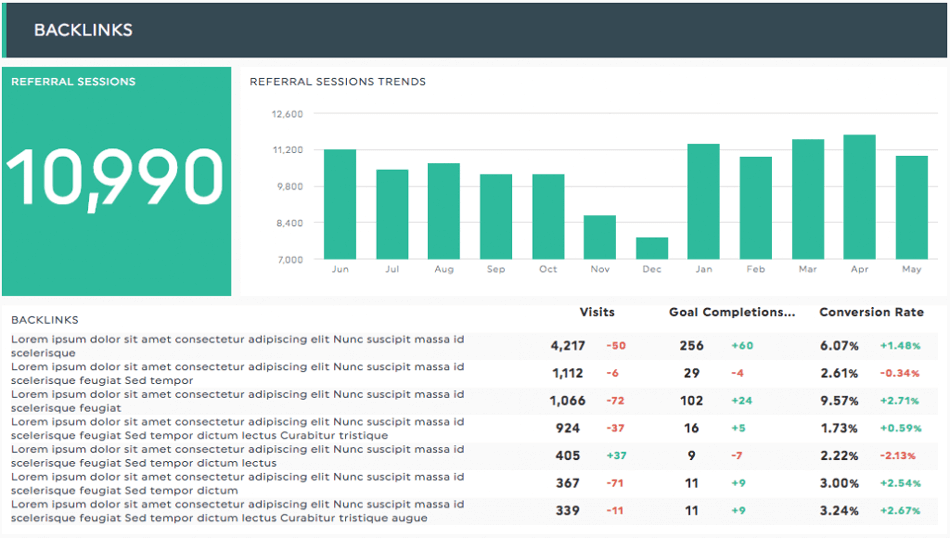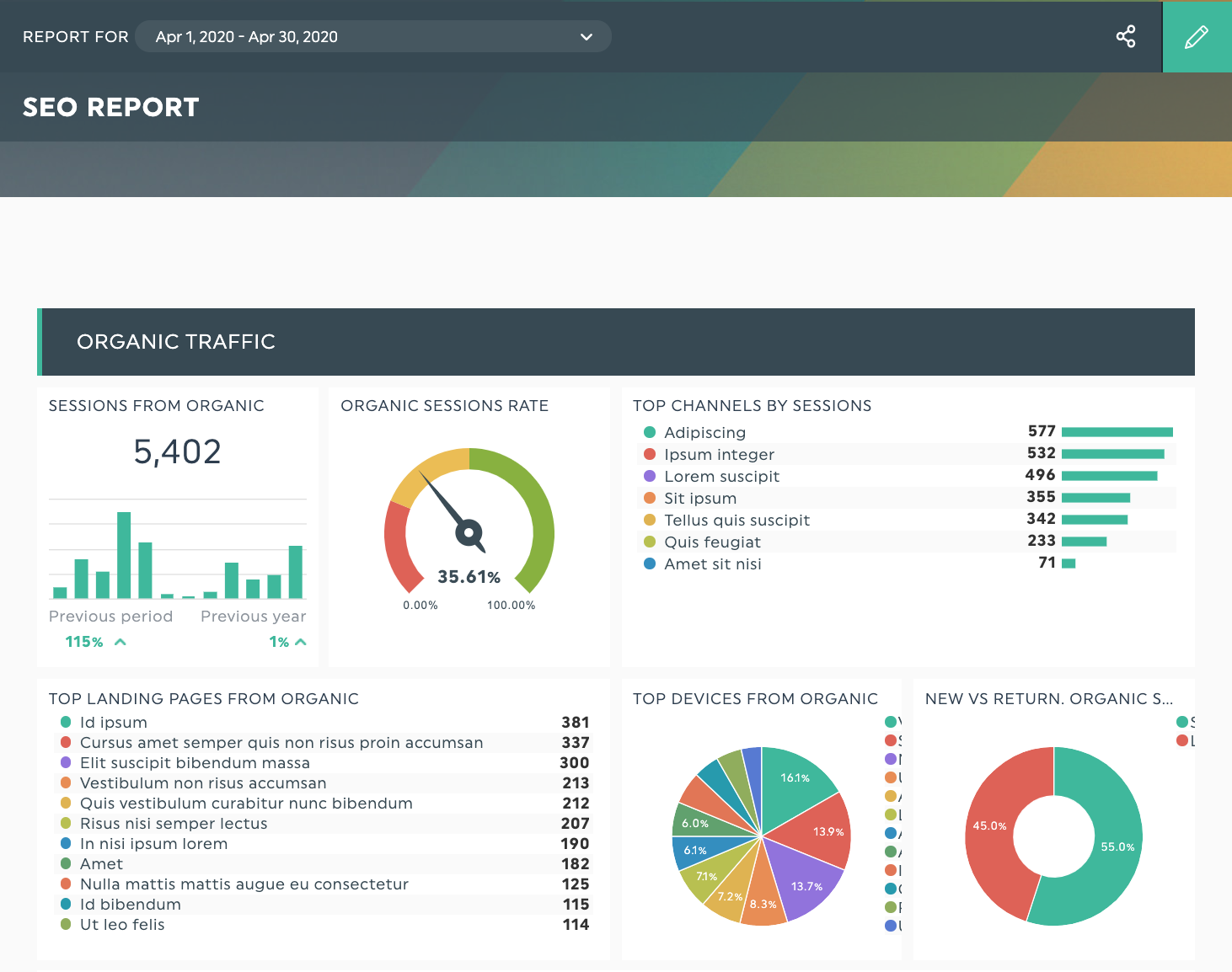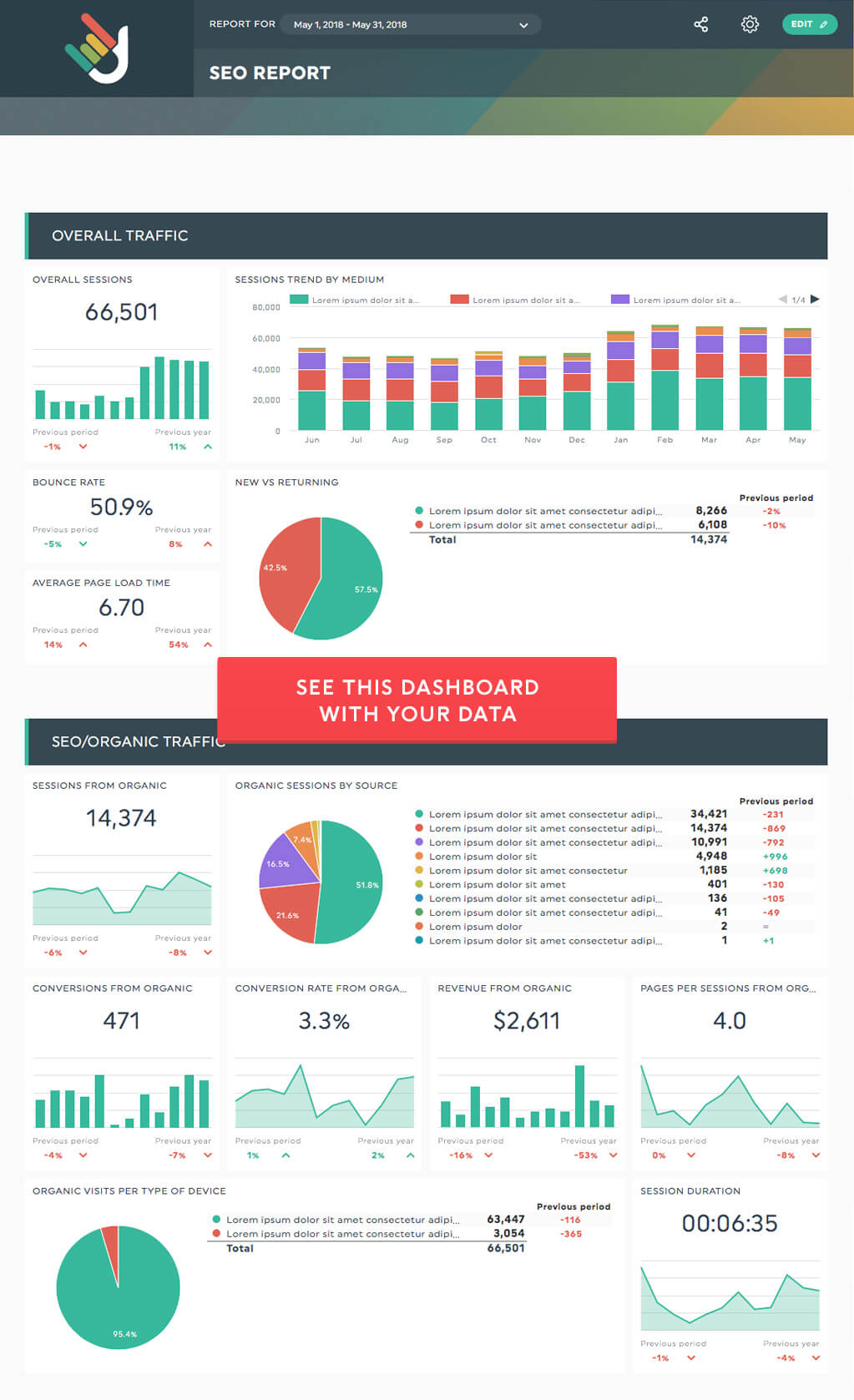How to create the ultimate SEO report for your clients

Your client doesn’t read your SEO reports?
Do you feel they don’t appreciate all your work in reporting their website’s search engine optimization and SEO reporting?
SEO reports are both your way of determining if your strategies are working and crucial in showing your results to your clients. Since this directly impacts your bottom line, it’s non-negotiable for any digital or SEO agency; you must quickly create well-built, outstanding SEO reports. Your clients also have to understand the next steps in their marketing strategies or the decisions you’re taking and see where their money is allocated.
You've come to the right place if you want to up your SEO reporting game. We’ll show you exactly how to create reports your clients will want to read and be excited about. So let’s see a good example of what your monthly SEO report should look like!
Pretty neat right? Now let’s see how to get there! But before we start, let’s go back to the basics of what makes an SEO report great. If you want to jump straight to the steps, click here.
What is an SEO report?
An SEO report is a comprehensive document usually prepared by data analysts, marketers, or a marketing agency to assess and communicate the SEO performance of a website. It includes various metrics and analyses related to site health, including organic traffic, keyword rankings, backlink profile, and overall visibility on search engines. This report serves as a vital tool for understanding how well the website is optimized for search engines and addresses the client's needs, outlining areas for improvement and strategies to enhance online presence and performance.
As you know, search engine optimization is a long-term investment. Evaluating your strategies is best-done month-over-month so that you don’t get bogged down with tiny details that can change quickly and for no reason. So, although you could theoretically create weekly marketing reports for your client's website or even daily SEO reports, monthly SEO reports are generally best.
What should be included in an SEO report?
An SEO report should include a range of key metrics and analyses to provide a comprehensive overview of the website's performance and its optimization for search engines. Here are some essential components that should be included:
- Executive Summary: A brief overview highlighting the main findings and key recommendations.
- Traffic Analysis: Data on organic search traffic, including page views, sessions, and trends over time.
- Keyword Performance: Analysis of your keyword research, including top-performing keywords, changes in rankings, and opportunities for improvement.
- Backlink Profile: Evaluation of the website's backlink profile, including the number of backlinks, quality of backlinks, and any changes in backlink acquisition.
- Recommendations: Clear, actionable recommendations for improving SEO performance and page authority based on the report's findings, including short-term and long-term strategies.
Which tool should you use to create an SEO report?
Creating an SEO report manually with an Excel sheet can be time-consuming and challenging due to the need to gather data from various sources, compile it, and then analyze it comprehensively. This process often involves pulling data from multiple SEO tools such as Google Analytics 4, Google Search Console, SEMrush, Moz, Hubspot and others, which can be laborious and prone to errors.
However, DashThis offers a streamlined solution to this problem. DashThis is a complete reporting tool that automates creating SEO reports by integrating various data sources and providing customizable templates.
How to create the perfect SEO report for your clients
1. Determine your objectives
First, you need to know what objectives your client has in mind. Sit down with the business owner or marketing specialist and ask them about what they are looking for in terms of overall marketing strategies (PPC, social media, etc.) and SEO campaigns. Discuss their current SEO goals with them, make an SEO analysis and/or SEO audit first, and verify how they align with their business objectives. Make sure to outline these goals clearly with your client.
For example, their goals may be:
- To bring more traffic to their site;
- To increase their overall sales;
- To improve their SERP (search engine results page);
- To enhance their engagement.
Do they want all of the above? Make sure you concentrate on a few goals at a time; having too much on your plate can only result in a Chinese buffet level of indigestion. However, remember that improving one goal can affect another since they’re all connected. More traffic doesn’t necessarily bring more sales, but it can help. Whereas the wrong traffic could potentially hurt engagement.
More importantly, you’ll want to explain how your chosen SEO goals will impact your client’s overall business. By outlining what you’re working towards and why, you’ll give direction to your report and set your client’s expectations.
Then, you need to build your SEO strategies to reach these objectives/goals. Where should your SEO efforts be focused to meet these goals?
For example, if your client wants to increase the organic search traffic to their site, you’ll want to focus on improving their keyword rankings and link building. To show how you’ll do this, you need to outline your plan of attack, ensuring the most relevant information doesn’t get lost among a bunch of data irrelevant to your current goal.
Don’t forget to highlight what you have already done towards meeting this goal, may it be doing an SEO site audit, optimizing on-page SEO, landing page optimization, new backlinks, reducing SEO errors on all pages, adding meta descriptions, updating robots.txt files, updating title tags, adding new external links, or all other SEO tasks. Show them the historical trends. This will give you and your client a clear idea of where you stand and where you need to go.
2- Establish the KPIs you need in your SEO report
You can’t create a good SEO report without knowing what KPIs to include and why. So here is a quick overview of what you should keep in mind.
First and foremost, remember always to show your results in hard numbers; nobody wants goals that aren’t measurable! Your reports should show numbers you can rely on and track easily over time.
It’s also important to be honest and show the wrong numbers when they happen. You can always turn bad results into positives; sometimes, you must remind your clients that fluctuations are normal. We all want to look good and show our best profile, but this isn’t Tinder, so remember to be transparent; it’ll be worth it!
With that in mind, here are some of the most relevant SEO KPIs (key performance indicators) to include in your website’s SEO report;
Traffic

Your clients are most probably wondering: where’s my website traffic coming from and how do I get more of it? Answer them!
This is one of the most common SEO goals out there: increasing organic traffic. If your client has this goal in mind, make sure your SEO report includes your client’s site traffic generated through organic search AND paid search.
This will allow them to compare the traffic their website generates organically with the traffic from their ads, thus allowing you to highlight the impact one might have on the other! Don’t forget to take a look at the click-through rate on your ads. This website analysis of the traffic can really help your client understand the SEO value.
Also, always include the direct traffic in your SEO report, as well as the referral, in order to answer the age old question: who’s bringing traffic (or not!) to your website.
Tools to track this KPI: Google Analytics
Engagement

Now that we know where the traffic comes from, let’s talk about where they’re going! A crucial metric to include in your SEO report is the bounce rate; a high bounce rate may indicate that the website doesn’t meet visitors’ expectations and would need a change! Maybe it's about your site speed, user experience, or content quality.
You want your visitors to stay a little while and visit your website; average session duration, page per session, and time on site are important metrics because they show if your visitors explore the website in depth, are interested in your client’s content and products… or not.
Don’t forget to display all these KPI page by page to give a good overview or the top performing pages, landing pages or blog posts.
These KPIs are particularly important if your client’s objective is to increase engagement, which should ultimately increase conversions, right?
Tools to track this KPI: Google Analytics
Conversion rate

Speaking of conversions… Be sure to include conversion data, since it’ll demonstrate your good work and the value you bring to your client’s business! These are KPIs you need to add, particularly if your client’s goal is to increase the number of sales, form completion, or downloads through his website.
A high conversion rate and conversion volume directly indicates how your SEO efforts are paying off and how many leads are created thanks to your optimized website! With these KPIs, you can verify which page converts best, and which ones are not reaching their goals.
You can then tweak the pages that don’t perform as well and reproduce what is working best on other pages.
Tools to track this KPI: Google Analytics
Keyword performance
A tremendous part of SEO revolves around keywords: you want to know which are the most performing keywords!
Make sure you know which specific keywords improved in the rankings, how search visibility has changed, and of course, your average position in your target keyword searches results.
All of this will give you a better idea of what to focus on next.
Tools to track this KPI: Google Search Console, SEMrush
Links

Never underestimate the power of backlinks! Make sure to include the domain authority metrics of those backlinks on your SEO report, as well as the new and lost referring domains.
Why? Well, you need to make sure that you have relevant inbound links, that your backlinks not only have good domain authority, but also that they are great, credible sources with the right anchor text. If not, they could actually hurt your ranking, and what you want for your client is a healthy backlink profile. Don’t forget to make sure you don’t have too many broken links too!
Also, by tracking the new and lost referring domains, you can quickly see when something is wrong and fix the situation accordingly!
Tools to track this KPI: Google Search Console, Google Analytics, Ahrefs, Moz
Page speed and performance
Have you ever googled a random topic on your mobile to prove a point and clicked on a link that took so long to load on your phone that you decided to go back and pick another one? Yeah, me too!
This is why page speed and site performance are key metrics that need to be on your SEO report. As a general rule of thumb, make sure your page speed always stays under 3 seconds; this can dramatically improve your SEO ranking. Particularly if your competition still has slower pages, this will give you a serious edge.
Tools to track this KPI: Google Analytics
3. Build and share your SEO report
There are two ways to build your SEO reports; automatically or manually.
With automated solutions like DashThis, creating a beautiful, client-friendly SEO report is as easy as 1-2-3! Let me show you how:
Steps to create your SEO reports automatically with Dashthi
- Connect your integrations;
- Choose your report type and pick a SEO template;
- Customize it with your own KPIs, insight, comments, images, and headers.
- Set up an automatic email dispatch;
- Forget about it!
However, creating your reports manually takes a bit more time.
Steps to create your SEO reports manually
- Go into each one of your digital marketing tools, SEO analyzer, and SEO audit tools, like Google Analytics, Google Search Console, Ahrefs, and SEMrush, to gather all the data you’re tracking;
- Fetch all your SEO metrics by entering into your (or your client’s) account for each tool, going into each software, and searching for the right KPIs;
- Adjust the time frame and hope you don’t have to do it all over because you missed a date;
- Find the way to export that data into an excel spreadsheet;
- Copy-paste it into another excel spreadsheet;
- Try to make it readable by creating some graphs, playing with the values, columns, layout, alignment, colours, and fonts;
- Noticing it looks pretty bad and give it to your graphic designer so that (s)he can take care of the layout for you;
- Trying to export your designer’s document into a pdf to present it to your client;
- Repeat this process with every one of your clients’ data.
- Export your report as a PDF;
- Attach your report in an email;
- Make sure you didn’t make typos;
- Send to your client;
- Repeat steps 1 to 4 for all your clients;
- Repeat the entire process next month, and the month after that, and the month after that, hoping your client doesn’t request a weekly report.
You know the drill!
So, why are you creating your reports manually when this can all be automatic?
It takes about five minutes to set up your automatic SEO report, and your clients will get them promptly, with up-to-date data, every month. You heard me, you don’t have to come back and enter the new data monthly, it’s all updated automatically!
Look at that!
You can even clone your reports for all your clients, whether you have 5, 30, or 100, and add personalized comments and insights for each of them.
You don’t want to lose your unique style? Don’t you worry, if you need more customization in your reports, you’ll love the white label options; you can have your own branded URL and uniquely designed custom reports, just how you like them.
SEO reporting best practices
Effective SEO reporting is crucial for marketers to communicate the value of their efforts and demonstrate progress to stakeholders. Here are three best practices for SEO reporting:
- Provide Actionable Insights: Beyond presenting data, offer valuable insights that stakeholders can use to make informed decisions. Interpret the data to highlight successes, identify challenges, and recommend strategies for improvement. For example, if organic traffic has increased, analyze the contributing factors such as content marketing optimizations, backlink acquisition, or technical enhancements. Likewise, if rankings drop, investigate potential causes like algorithm updates, competitor activity, or technical issues and suggest actions.
- Visualize Data Effectively: Use visual elements such as charts, graphs, and tables to present data clearly and compellingly. Visualizations can help stakeholders quickly grasp trends, patterns, and relationships within the data without getting overwhelmed by raw numbers. Choose visual formats that best represent the information you're conveying, whether it's a line chart for tracking changes over time, a pie chart for illustrating distribution, or a heatmap for identifying areas of opportunity.
- Benchmark Performance Against Goals and Competitors: Provide context for your SEO performance by benchmarking against established goals and industry competitors. Set clear, measurable objectives for key metrics such as organic traffic growth, keyword rankings, and conversion rates, and regularly assess performance against these benchmarks. Additionally, analyze competitor performance to identify areas of opportunity and competitive threats, inform your SEO strategy, and prioritize initiatives that can help you outperform rivals in relevant search engine results.
Here's a short video on how to create and customize your SEO report in 5 minutes:
You now have everything you need to create efficient, simple, and beautiful SEO reports that your clients will love!
Not sure if DashThis is the right solution for your reporting needs? Try it free for 15 days! A free trial never hurt anybody!
We know we made the best SEO reporting software, but don’t take my word for it, just read what our clients have to say about us!
Create powerful SEO reports for your clients today!
Read More
Don’t miss out!
Automate your reports!
Bring all your marketing data into one automated report.
Try dashthis for free



